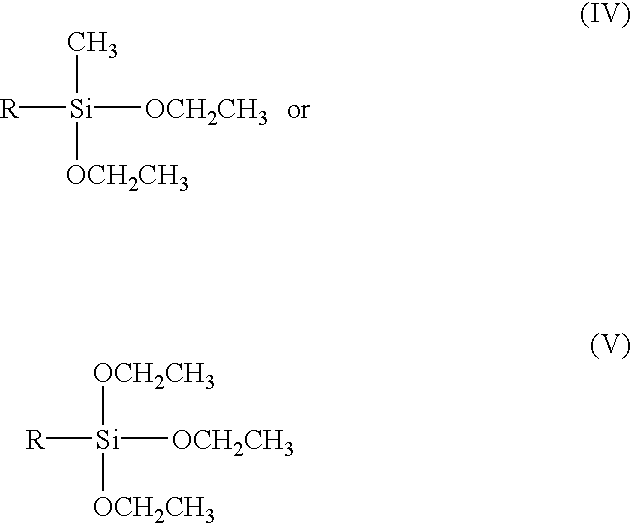Polymerization of silicone in a surfactant medium
- Summary
- Abstract
- Description
- Claims
- Application Information
AI Technical Summary
Benefits of technology
Problems solved by technology
Method used
Image
Examples
example 1
Amino-Functional Polymer
71.43% of a hydroxy-terminated silicone fluid(Dow Corning 1-3663 ) and 0.72% of (N-(2-aminoethyl)-3-aminopropylmethyldimethoxy silane) (AP Silane-31, available from Advance Polymers) were charged to a 316 stainless steel reactor and mixed for 10 minutes under low agitation with a radial flow sweep blade. Thereafter, 0.14% of an aqueous solution of 50% NaOH in water was charged to the vessel along with 8.66% trimethyl nonanol with 6 moles ethylene oxide (Tergitol TMN-6, available from Union Carbide) and 5.77% C9-15 chain alcohol with 6-8 moles ethylene oxide (Tomadol 91-6, available from Tomah). The vessel was then heated to 60-65.degree. C. and held for one hour, while polymerization proceeded. The cooling of the vessel was then begun and 11.54% water and 1.44% dipropylene glycol were charged. The vessel was brought to 25-30.degree. C. as quickly as possible, and the components were further mixed for 30 minutes. After this 30 minutes of mixing time, 0.29% Gla...
example 2
70.40% of a hydroxy-terminated silicone fluid(Dow Corning1-3663) and 2.93% of (.gamma.-glycidoxypropylmethoxy dimethoxy silane) (AP Silane-55, available from Advance Polymer) were charged to a 316 stainless steel reactor and mixed for 10 minutes under low agitation with a radial flow sweep blade. Thereafter, 0.14% of an aqueous solution of 50% NaOH in water was charged to the vessel along with 8.00% Tridecyl Alcohol 9 moles EO and 5.87% Tridecyl Alcohol 3 moles EO. The vessel was then heated to 60-65.degree. C. and held for three hours, while polymerization proceeded. The cooling of the vessel was then begun and 11.74% water. The vessel was brought to 25-30.degree. C. as quickly as possible, and the components were further mixed for 30 minutes. After this 30 minutes of mixing time, 0.12% Glacial acetic acid was charged to neutralized the catalyst. The contents of the vessel were further mixed for one hour, after which the product was directly tested.
example 3
Fluoro-Functional Polymer
70.40% of a hydroxy-terminated silicone fluid(Dow Corning-3663) and 2.93% of ((3-3-3-trifluoropropyl)trimethoxy silane) (AP Silane-75, available from Advance Polymer) were charged to a 316 stainless steel reactor and mixed for 10 minutes under low agitation with a radial flow sweep blade. Thereafter, 0.14% of an aqueous solution of 50% NaOH in water was charged to the vessel along with 8.00% Tridecyl Alcohol 9 moles EO and 5.87% Tridecyl Alcohol 3 moles EO. The vessel was then heated to 60-65.degree. C. and held for one hours, while polymerization proceeded. The cooling of the vessel was then begun and 11.74% water. The vessel was brought to 25-30.degree. C. as quickly as possible, and the components were further mixed for 30 minutes. After this 30 minutes of mixing time, 0.12% Glacial acetic acid was charged to neutralized the catalyst. The contents of the vessel were further mixed for one hour, after which the product was directly tested.
PUM
| Property | Measurement | Unit |
|---|---|---|
| Temperature | aaaaa | aaaaa |
| Fraction | aaaaa | aaaaa |
| Fraction | aaaaa | aaaaa |
Abstract
Description
Claims
Application Information
 Login to View More
Login to View More - R&D
- Intellectual Property
- Life Sciences
- Materials
- Tech Scout
- Unparalleled Data Quality
- Higher Quality Content
- 60% Fewer Hallucinations
Browse by: Latest US Patents, China's latest patents, Technical Efficacy Thesaurus, Application Domain, Technology Topic, Popular Technical Reports.
© 2025 PatSnap. All rights reserved.Legal|Privacy policy|Modern Slavery Act Transparency Statement|Sitemap|About US| Contact US: help@patsnap.com



